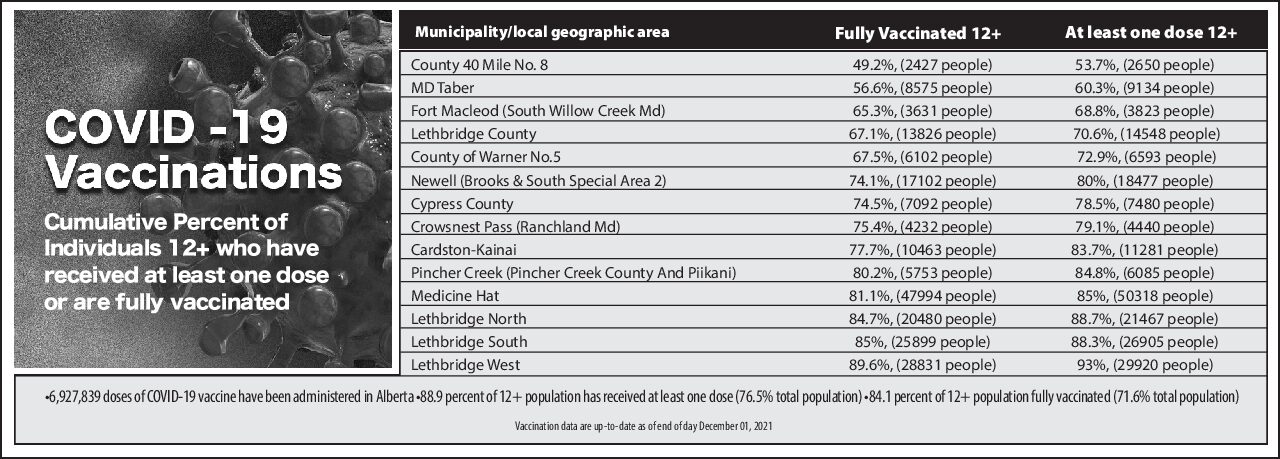Lead Medical Officer of Health says numbers don’t tell the whole immunization story with County of Forty Mile
Posted on 8 December 2021 by adminis
Local Journalism Initiative Reporter
While the County of Forty Mile currently sits at 53.7% of the 12 and up population being fully vaccinated as of December 3rd, the issue may not be solely geographical, said Dr. Vivian Suttorp, Lead Medical Officer of Health in the south zone with Alberta Health Services.
“If you look at 12 and up being eligible when this data was pulled on the 23rd of November, and you can look at overall numbers. So the County of Forty Mile doesn’t have a high population. In fact, when I look at those 12 and up, it’s just under 5000,” said Suttorp. “That tells me from this data that there’s just over 2500 individuals who are eligible who are told enough who aren’t immunized. So there’s 2558 According to the calculation as of Tuesday that aren’t immunized. So look at if you look in Taber MD which includes Vauxhall, then Grassy Lake area, that sort of area there and the overall immunization rate is a bit better. Like that. The County of Forty Mile is at 48.2% for 12 and up two doses. Taber is 55.8% So it doesn’t highlight on the map in the really light color. But there’s 6649 people running around who are not immunized at all.”
It’s also worth noting to look into other demographics than geography, said Suttorp, who noted that the county has a much higher immunization rate in those aged 75 or older, with 80.9% of the 75+ population in Forty Mile fully immunized, but rates are much lower with younger groups across Southern Alberta.
“The biggest differences in the working group, the working age group. They are sort of the 20 to 39 year olds. That’s a very low immunization rate. And that’s sort of the same in 12 to 19 as well. But those are, that’s the younger populations that are less immunized. And that’s consistent across all geographies,” said Suttorp. “So looking at geography, but also looking at age groups, and then we look at the total number of people living there. Because if you have 10 people in an area well, and nobody’s immunized, okay, they may get COVID And it’s done. But if you have 1000s of people not immunized that go to school, that shop, and do other activities together, it’s actually a bigger risk.”
However, this lower rate of vaccination for COVID-19 runs parallel to the rate for influenza, said Suttorp, as well as those for childhood immunizations.
“There is a parallel to vaccine hesitancy for childhood vaccines and COVID vaccination,” said Suttorp. “And again, this is COVID vaccination for adults for 12 minutes. Right. So that’s one comment. And so there’s definitely a geographic difference. And there’s also an age group difference.”
The reason behind this comes down, largely, to misinformation and social pressure, said Suttorp.
“I think there’s a lot of misinformation out there on the internet, social media, I think that’s probably the largest concern around misinformation around vaccines,” said Suttorp. “So that is probably the single most challenge that we’re facing, and individuals are facing, just not knowing who to believe. As much as it’s positive to have social media and be able to get things out quickly. And you know, this is all fantastic. I came before an era of computers, almost. But it’s also, it can be counterproductive, because we have people say they don’t know who to believe.”
“There also becomes sort of a norm, right as part of this population, or this group or this organized group, right? Like we’re saying, we are not going to immunize. And so there are also some, potentially some, I don’t know if it’s social pressure, I call it that maybe it’s not the right term. But sometimes there are right people will we’ve had people wanting to be immunized not in a public health office. Because they don’t want to be seen coming to public health. They want vaccines, but they don’t want to come to a big clinic,” said Suttorp.
With both of these factors, it can become a challenge for people to access vaccines in smaller counties.
“My biggest concern is that individuals are free, completely free to make the decision that fits for them with the right information, to help them navigate through all the different types of information out there. And then is there a sort of a safe place to get vaccinated? So having more options through physicians through pharmacies and public health offices, there are different options. But I do believe what we see on the front line and we see this, we saw it through measles, we saw it through other outbreaks, whooping cough, we see it with mumps, all these outbreaks we’ve had that are vaccine preventable,” said Suttorp. “It’s a pretty consistent story that there are people and not just one or two, it’s quite a number who do wish for vaccines. But they somehow don’t feel safe. To get this from the public, safe in the sense not that public health is not safe, but that they’re being safe, that they’re getting immunizations. And I find that, you know, how do we support individuals to make that right decision for them, that’s not influenced by social norms or social pressures, and that they feel free, and they can actually access it, where they where they wish.”
An official at the County of Forty Mile office in Bow Island declined to comment.
Leave a Reply
You must be logged in to post a comment.
